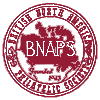BNAPS Railway Post Office Study Group
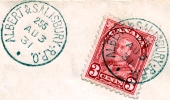
MT-1 ALBERT & SALISBURY R.P.O.
Train 255, 3 Aug. 1931

QC-98 LEVIS & RIVIERE-DU-LOUP RPO
J. A. DIONNE
(RPO clerk name)
Train 45, 18 Dec. 1915

RY-87 HALIFAX & S.W.R'Y. R.P.O.
East, 18 May 1910

SN-10 HAMILTON / CANADA
11 AM, 22 Nov. 1910
Duplex used at GTRy station
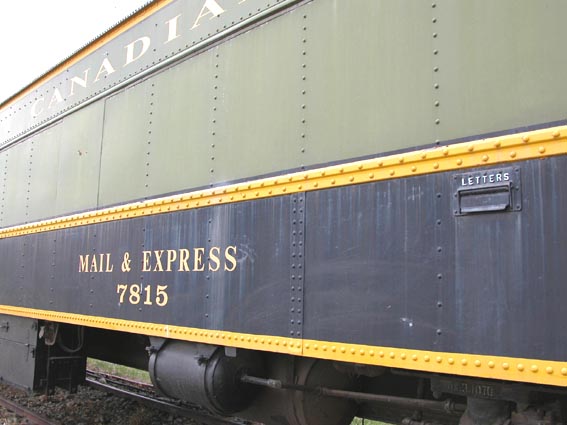
Mail slot in the railway mail car
The photo was taken by Robert K. Lane at the Edmonton Railway Museum.
Here is a glossary of terms used by RPO collectors.
Postmark - Sometimes called "cancellation", recognizing that a postmark becomes a cancellation only when it defaces a stamp. Most railway hammers were used both as cancellation devices and for the application of postmarks and transit markings.
P.C., M.C., R.P.O. - A rail car equipped and staffed for handling mail. P.C. (= Postal Car) appears on some early postmarks. M.C. (= Mail Car) was the term that followed and also appears on some postmarks. R.P.O. (= Railway Post Office) is the most recent and most common expression. It appears on many postmarks.
RPO - A term often referring to any postmark used on a rail car (e.g.: "She collects RPOs from Quebec").
Listing - The entire entry for any RPO postmark of a given type. Each major listing is represented by a Listing Number, as found in the RPO catalogue compiled by Ross Gray.
Sub-Listing - Within the permanent lettering of a given postmark, there can be one or more variations that indicate such things as direction, route, time mark, clerk or steamer name. These variations do not constitute a new major type of postmark. They are listed as subtypes under a major listing number.
Listing Number - The listing of the railway cancellations in the RPO catalogue is divided into sections based on geography or purpose. Each section is assigned a prefix of one or more capital letters, as follows:
|
Newfoundland & Labrador Maritimes Quebec Ontario Western |
NL- MT- QC- ON- WT- |
Railways and Routes Station Offices Ticket Stamps Emergency Royal Train |
RY- SN- TKS- E- RV- |
Set - Includes all removable slug data within the center of a hammer, specifically, the day, month, year, train number, direction and/or time mark.
Indicia - Includes only that data in the set above the date, specifically, the train number, direction or time mark. This is somewhat of a misnomer, but is in common use.
- Train Numbers - Odd numbers indicate trains that went north or west. Even numbers indicate trains that went south or east.
- Direction Marks - NORTH, SOUTH, EAST, WEST, N, S, E, W
- Time Marks - AM, PM, or 9:00 AM, NOON, etc. (In Newfoundland, a letter sometimes appears above the date, giving some indication of time).
Hammer - A cancellation device of steel, rubber or other composition containing permanent, non-replaceable lettering, as shown in each listing under "Postmark". Most listings are known with two or more hammers. Identification of each of these multiple hammers varies from simple to difficult, depending on individual characteristics, but all hammers for any given listing will read alike in all major components.
Proof - Postmark registered in one of the several Pritchard & Andrews ledgers prior to delivery of the hammer by the maker against a government requisition.
N.I.P.B. - "Not in the Proof Book". Many hammer proofs were not available for inclusion in the proof books.
O.P.K. - "Only Proof Known". Listings with this designation are known only from the proof strike, and may or may not have been put into actual service.
O.D.O.K. - "Only Destruction Order (strike) Known". Listings known only from strikes in the official register prior to the destruction of the hammer.
ERD - Earliest recorded date of use; also EKD (earliest known date).
LRD - Latest recorded date of use; also LKD (latest known date).
Facing Slip - An approximately 3" x 5" piece of paper, usually showing run and clerk strike. The slip of paper is placed in mail bags after sorting to identify the mail clerk involved.
Rarity Factor (RF) - The RF of any given listing in the RPO catalogue is based on the period of use of the cancelling devices for that listing.
Here are several RPO examples with explanations.
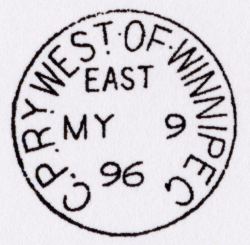
|
RY-30.31 (RY designates a "Railways & Routes" category) Circle style RPO, no hammer designation EAST direction MY 9 / 96 (9 May 1896) |
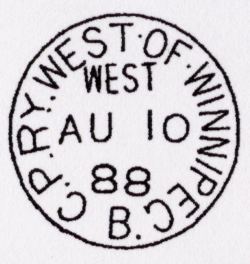
|
RY-30.12 Circle style RPO, Hammer B WEST direction AU 10 / 88 (10 August 1888) |
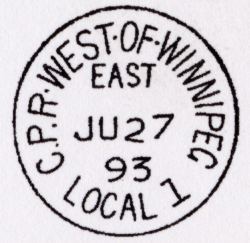
|
RY-31.01 Circle style RPO, "LOCAL" Hammer 1 EAST direction JU 27 / 93 (27 June 1893) |
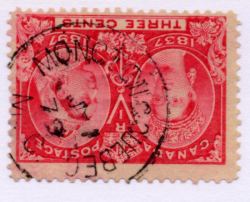
|
MT-257 (MT designates a "Maritime" category) MONCTON & QUEBEC / M.C. (M.C. = Mail Car) Circle style with larger spacing between the circle and the RPO name Mail Car without a hammer number ?? ? 79 (error for "97" since the stamp was issued on 19 June 1897) |

|
WT-778.01 (WT designates a "Western" category) SOURIS & WINNIPEG / M.C. (M.C. = Mail Car) Squared circle style, Hammer No. 1, no indicia OC 23 / 08 (23 October 1908) |
Copyright © 2015 - 2026 The British North America Philatelic Society.
The documents on this website are for informational and non-commercial or personal use only.
Documents on this website shall not be used on other websites or for
commercial purposes without permission.
This page was last modified on 2024-01-02
